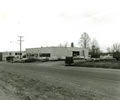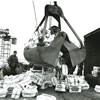 |
|
|
 |
 |
|
|
| |
|
|
|
- A fire, apparently started by lightning, destroyed the new office building in LaVergne on May 24, 1960, just a few days before the facility was to be occupied. On Dec. 19, employees moved in to the rebuilt office.
- Ellington Agricultural Center becomes home of the Tennessee Department of Agriculture. Tennessee is the only state to have a department of agriculture located on a farm.
- The addition of outdoor advertising rounds out TFC’s communication program and provided a valuable additional link with our farm market Beginning with a saturation program of some 350 outdoor posters in January, this program was coordinated with television, radio, direct mail, and other advertising.
|
 |
|
|
 |
|
 |
|
|
 |
 |
 |
|
|
| |
|
|
|
- In May, construction begins on second feed mille in Tenco.
- On Sept. 10, the last single-county Co-op to be established, DeKalb Farmers Cooperative, opens for business, bringing the total of member Co-ops to its largest number at 88.
- Ag Chemicals reaches a major milestone – the $1 million sales mark – with a 51-percent increase over 1960 sales.
- Farmers Chemical Association was created to help TFC become basic in raw fertilizer materials. Besides TFC, members are Cotton Producers Association of Atlanta, Southern States Cooperative of Richmond, and Farmers Cooperative Exchange of Raleigh.
|
 |
|
|
 |
|
 |
|
|
 |
 |
 |
|
|
| |
|
|
|
- Second feed mill opens at Tenco.
- “Little Co-op man” first appears in January 1962 in an advertisement for Co-op plant food. He becomes an marketing icon for the Co-op system through the late 1960s.
|
 |
|
|
 |
|
 |
|
|
 |
 |
 |
|
|
| |
|
|
|
- In 1963, some of the first research plots in no-till crop production are studied at the Highland Rim Experiment Station in Springfield. Advantages are listed as reduced labor costs, less time required for planting, and maintaining soil structure and erosion control. These plots are an extension of minimum tillage research that began in 1960 by Henry Andrews at the UT Agricultural Experiment Station.
- On July 17, “Tennessee Day” was held at the Farmers Chemical plant in Chattanooga, giving some 4,000 people a firsthand look at TFC’s “Green Charger” nitrate facilities. The facility produces anhydrous ammonia, ammoniating solutions, prilled ammonium nitrate, direct application solutions, and urea.
- A full color motion picture titled “Truly Tennessee” is produced as a public relations medium for the Co-op system. The film was designed to re-emphasize the benefits of belonging to a cooperative, provide an up-to-date appraisal of TFC and county facilities, and explain the advantages of the Co-op way of doing business.
|
 |
|
|
 |
|
 |
|
|
 |
 |
 |
|
|
| |
|
|
|
- As a result of the changes in by-laws adopted at the 1963 annul meeting, fiscal year changes to July 31. The first seven months of 1964 became an interim year of five months less than normal duration.
- TFC’s first proprietary variety of seeds is introduced – GHS 1, a sudan-sorgum hybrid. More than 1 million pounds of seed are sold.
|
 |
|
|
 |
|
 |
|
|
 |
 |
 |
|
|
| |
|
|
|
- FC becomes a member of Cooperative Research Farms (CRF), which was established in 1954. Today, CRF continues to conduct research on animal nutrition and practical feeding problems at three research farms and through external contracts with various universities. CRF, the largest network of feed research farms in the United States, is owned by TFC, other regional cooperatives, and private feed manufactures serving customers in the U.S., Canada, and France. Its headquarters are in Richmond, Va.
|
 |
|
|
 |
|
 |
|
|
 |
 |
 |
|
|
| |
|
|
|
- First load of cooperative Gold Crest twine to be transported by barge arrives in Tennessee from New Orleans. Lower water transit costs make it more convenient and cost-effective for volume purchase of twine. Some 51,500 bales, each with 9,000 feet of twine, are in this first barge shipment, enough for 25 million bales of hay.
- A new motor oil Co-op Director, was introduced and with it a program hailed as an “industry first.” This new motor oil, designed to be used in any tractor or automobile engine, comes with a Co-op Oil-Engine Warranty that increased the manufacturer’s warranty to three years or 3,000 hours of actual operation.
- The “new” Co-op Farm Service Center with one-stop shopping is a developing trend. Officials say these types of stores are “destined to portray the face of the future of our Co-ops in Tennessee.” Foretelling a building boom for new Co-op stores, this concept concentrates virtually all aspects of the farmers’ business under one roof for greater efficiency and convenience.
|
 |
|
|
 |
|
 |
|
|
 |
 |
 |
|
|
| |
|
|
|
- A new addition containing 19,700 square feet is occupied at TFC headquarters building in LaVergne.
- A $1 million modernization project at LaVergne and Tenco fertilizer plants will produce 6-12-12 in granular form, which is better suited for bulk distribution. The product will also be packaged in plastic bags as a result of the installation of new sealing units.
- TFC’s third feed mill, named in honor if the late Thomas Phillips who was assistant to the general manager when he died two years earlier, celebrates its grand opening July 20 in Jackson. Operations began Dec. 26, 1966 and by Feb. 1 all West Tennessee tonnage came from of the new plant.
- TFC’s accounting department becomes the first to be computerized. At this time, TFC’s computer complex consists of seven internally connected machines governed by a central processor. Although used exclusively for accounting at first, officials have “a great many application … statistical evaluation and feed formulations, to mention only two.â€
- Construction of new Co-op faculties progresses at a record pace across the state. This trend will continue through the next several years.
|
 |
|
|
 |
|
 |
|
|
 |
 |
 |
|
|
| |
|
|
|
- The new Jackson fertilizer plant is dedicated during a grand opening held July 30 on its 100-acre site six miles northwest of Jackson. Some 3,000 people attended theevent, during which a new 1968 Ford pickup was given away. The plant was in full production by December.
- Feed production reaches 1 million tons on Nov. 19, 1968.
- Flotation fertilizer spreading is tested in West Tennessee.
|
 |
|
|
 |
|
 |
|
|
 |
 |
 |
|
|
| |
|
|
|
- On Dec. 29, the LaVergne seed plant is destroyed by fire.
- Our modern-day Co-op logo first appears in Cooperator ads in October 1969.
- An on-the-farm sales and service program is added to the farmer in the field.
|
 |
|
|
 |
|
 |
|
|
 |
|
  |
|